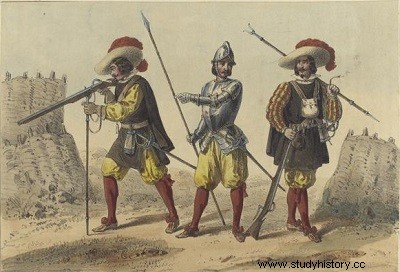
Pikemen are Renaissance infantry armed with a very long spear called a pike.
Origins
Infantrymen armed with a pike several meters long, they formed the basis of the armies of the late Middle Ages and the Renaissance. They appeared from the beginning of the 14th century among the Scots and the Flemings. But the most famous were certainly the Swiss.
Heirs of the Macedonian hoplites who formed the phalanxes of Philip II of Macedonia as well as Alexander the Great and all the Hellenistic kings. Their main function was to block cavalry charges.
Rebirth
They are then at the center of the military evolution that characterizes the Renaissance:the generals, inspired by Antiquity and Swiss formations, provoke a return of the infantry as the basis of military power, to the detriment of the gendarmes (man of mounted weapon forming the heavy cavalry of armies). Indeed, compact formations of infantry armed with pikes are now able to defeat heavy cavalry charges, which at the time remained one of the major assets of battles.
Two elements are at the origin of the adoption of Swiss tactics as the foundation of the new infantry that was taking shape throughout Europe. On the one hand, from the end of the 15th century, certain observers and humanist reformers noticed the link between the square of Swiss pikemen and its ancient equivalents, Greek phalanxes or Roman formations. On the other hand, the Swiss made themselves the ambassadors of what had become, in particular after their victories of Grandson (March 1476) and Morat (June 1476) against the Burgundians, a reference in terms of combat:coming from a country poor, thousands of Swiss mercenaries earned their living fighting abroad.
In the spring of 1480, Louis XI brought together 10,000 adventurers and 2,500 pioneers in Picardy, destined to replace the militia of the franc-archers and to be maintained on a permanent basis.
These are the bands French, a new infantry commanded by Philippe de Crevecoeur, Sire d'Esquerdes, copied on the model of the Swiss bands, composed of halberdiers and pikemen.
Thus will be born, by imitation of Swiss practices, the first drafts of national armies. Thus, François I reorganized his infantry on a territorial basis by the ordinance of July 24, 1534. Burgundy, Champagne, Guyenne, Languedoc, Normandy, Picardy, Dauphiné and Provence must each provide 6,000 recruits intended for the formation of a "legion (a term taken directly from Roman antiquity).
During the 16th century, arquebusier units were added to the pike formations (the most famous are the Spanish tercios).
Evolution
They disappeared from the 18th century, in particular because of the invention of the socket bayonet which allowed the infantryman to shoot while having a weapon equivalent to a pike. More versatile and less complex to deploy, rifle regiments supplanted the old formations of musketeers and pikemen.
